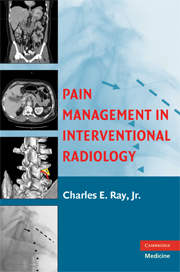Book contents
- Frontmatter
- Contents
- Contributors
- Preface
- Acknowledgments
- 1 Pain Management in Interventional Radiology: An Introduction
- 2 Clinical Evaluation of Low-Back Pain
- PART I LOCOREGIONAL PAIN CONTROL
- 3 Local Anesthetics
- 4 Functional Lumbar Spine Anatomy: A Review
- 5 Percutaneous Vertebroplasty
- 6 Kyphoplasty
- 7 Epidural Steroid Injections
- 8 Selective Nerve Root Blocks
- 9 Discography
- 10 Facet (Zygapophyseal) Joint Injections
- 11 Articular Interventions in Pain Management: A General Approach
- 12 Percutaneous Management of Visceral Pain
- 13 Embolization of Painful Neoplasms
- 14 Image-Guided Ablation of Painful Osteolyses
- 15 Chronic Pelvic Pain in Women
- PART II SYSTEMIC PAIN CONTROL
- Index
- References
8 - Selective Nerve Root Blocks
from PART I - LOCOREGIONAL PAIN CONTROL
Published online by Cambridge University Press: 04 September 2009
- Frontmatter
- Contents
- Contributors
- Preface
- Acknowledgments
- 1 Pain Management in Interventional Radiology: An Introduction
- 2 Clinical Evaluation of Low-Back Pain
- PART I LOCOREGIONAL PAIN CONTROL
- 3 Local Anesthetics
- 4 Functional Lumbar Spine Anatomy: A Review
- 5 Percutaneous Vertebroplasty
- 6 Kyphoplasty
- 7 Epidural Steroid Injections
- 8 Selective Nerve Root Blocks
- 9 Discography
- 10 Facet (Zygapophyseal) Joint Injections
- 11 Articular Interventions in Pain Management: A General Approach
- 12 Percutaneous Management of Visceral Pain
- 13 Embolization of Painful Neoplasms
- 14 Image-Guided Ablation of Painful Osteolyses
- 15 Chronic Pelvic Pain in Women
- PART II SYSTEMIC PAIN CONTROL
- Index
- References
Summary
INTRODUCTION
Flouroscopically directed selective nerve root blocks (SNRBs) were initially described by Macnab in patients with “negative disc exploration” (1). Macnab described needle tip position, reproduction of radicular pain, confirmation of placement with injection of contrast to produce a neurogram, and anesthetization of the affected nerve with lidocaine. The technique has not changed significantly since 1971.
The utility of an SNRB is reflected in the name. It should be selective and, as such, tends to have significant diagnostic and prognostic power in evaluating patients with unclear radicular etiologies. The injection, when combined with a steroid, can be therapeutic as well. In the lumbar spine, if therapeutic benefit is the goal, a transforaminal epidural steroid injection is of more utility with more volume able to be delivered to the affected level with reflux into the epidural space.
In our clinical practice, lumbar SNRBs are performed in order to pinpoint the affected levels in patients with unclear clinical symptoms or discordant symptoms that are discordant with the magnetic resonance images (MRI). It has also been shown to have significant prognostic importance in identifying the level for surgical intervention and in identifying those patients who will benefit from surgery (2,3). Cervical selective nerve root blocks (CNRB) are performed under similar clinical circumstances. Thoracic SNRBs are rarely performed but can have important diagnostic and therapeutic utility in uncommon clinical settings.
- Type
- Chapter
- Information
- Pain Management in Interventional Radiology , pp. 112 - 130Publisher: Cambridge University PressPrint publication year: 2008
References
- 1
- Cited by



